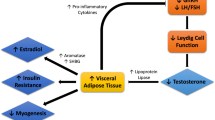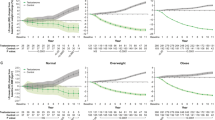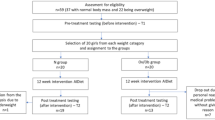Abstract
Hypothalamic amenorrhoea has been shown to be associated with hypercarotenaemia, but no causal link has been established. Many people are unaware of the health implications of carotenoderma. We report on a 36-year-old woman with normal body mass index and with a history of secondary amenorrhoea for 2 years and carotenoderma for 5 years. She had a history of practising a fixed-menu diet of predominantly leafy greens, exercised intensively and had a stressful job. Blood tests confirmed the presence of hypercarotenaemia and hypogonadotrophic hypogonadism. Carotenoderma subsided after 6 months of lifestyle modification, but she remained amenorrhoeic up to 12 months later. Since then, her condition had relapsed up to the time of 2 years of follow-up. We conclude that hypercarotenaemia/carotenoderma and hypothalamic amenorrhoea are manifestations of a constrained lifestyle rather than causally linked. The presence of carotenoderma should alert public individuals and clinicians, especially in primary care, alike for signs of potential health complications including reproductive dysfunction even without weight problems.
This is a preview of subscription content, access via your institution
Access options
Subscribe to this journal
Receive 12 print issues and online access
$259.00 per year
only $21.58 per issue
Buy this article
- Purchase on Springer Link
- Instant access to full article PDF
Prices may be subject to local taxes which are calculated during checkout


Similar content being viewed by others
References
Strumìa R, Varotti E, Manzato E, Gualandi M . Skin signs in anorexia nervosa. Dermatology 2001; 203: 314–317.
Kemmann E, Pasquale SA, Skaf R . Amenorrhea associated with carotenemia. J Am Med Assoc 1983; 249: 926–929.
Wiersinga WM, DeGroot LJ . Adult hypothyroidism. Thyroid Disease Manager 2010. Available at: www.thyroidmanager.org/chapter/adult-hypothyroidism/# toc-9-2-definition-and-epidemiology-of-hypothyroidism (accessed 16 May 2014).
Scientific Advisory Committee on Nutrition. Dietary Reference Values for Nutrition. TSO: London, 2011.
Schofield WN . Predicting basal metabolic rate, new standards and review of previous work. Hum Nutr Clin Nutr 1985; 39 (Suppl 1): 5–41.
Lean ME, Han TS, Deurenberg P . Predicting body composition by densitometry from simple anthropometric measurements. Am J Clin Nutr 1996; 63: 4–14.
Maiani G, Castón MJ, Catasta G, Toti E, Cambrodón IG, Bysted A et al. Carotenoids: actual knowledge on food sources, intakes, stability and bioavailability and their protective role in humans. Molec Nutr Food Res 2009; 53 (Suppl 2): S194–S218.
Lakshman MR . Alpha and omega of carotenoid cleavage. J Nutr 2004; 134: 241 S–245 S.
Haught JM, Patel S, English JC III . Xanthoderma: a clinical review. J Am Acad Dermatol 2007; 57: 1051–1058.
Svensson A, Vahlquist A . Metabolic carotenemia and carotenoderma in a child. Acta Dermato-Venereol 1995; 75: 70–71.
Han TS, Bouloux PMG . Kallmann syndrome and other causes of hypothalamic hypogonadism and related development disorders. In Fink G, Pfaff DW, Levine JE (eds) Handbook of Neuroendocrinology. 1st edn, Chapter 27, Academic Press, Elsevier: London, Waltham, San Diego, 2012, pp 597–618.
Braun M, Venter I . Awareness and knowledge of phytonutrient food sources and health benefits for functional food application among health food store customers in the Cape Town city bowl. J Family Ecol Consumer Sci 2008; 36: 30–39.
Glorio R, Allevato M, De Pablo A, Abbruzzese M, Carmona L, Savarin M et al. Prevalence of cutaneous manifestations in 200 patients with eating disorders. Int J Dermatol 2000; 39: 348–353.
Warren MP . Health issues for women athletes: exercise-induced amenorrhea. J Clin Endocrinol Metab 1999; 84: 1892–1896.
Acknowledgements
We thank Professor MEJ Lean, Rank Professor of Human Nutrition, Glasgow Royal Infirmary, University of Glasgow, Scotland, for his insightful comments.
Author contributions
All authors were involved in study design, drafting the manuscript and revising it critically, and read and approved the final manuscript.
Author information
Authors and Affiliations
Corresponding author
Ethics declarations
Competing interests
The authors declare no conflict of interest.
Additional information
Supplementary Information accompanies this paper on European Journal of Clinical Nutrition website
Supplementary information
Rights and permissions
About this article
Cite this article
Nyekiova, M., Ghaderi, S. & Han, T. Carotenoderma in a young woman of normal body mass index with hypothalamic amenorrhoea: a 2-year follow-up case report. Eur J Clin Nutr 68, 1362–1364 (2014). https://doi.org/10.1038/ejcn.2014.128
Received:
Revised:
Accepted:
Published:
Issue Date:
DOI: https://doi.org/10.1038/ejcn.2014.128
This article is cited by
-
Adrenal hypofunction associated with ashwagandha (Withania somnifera) supplementation: a case report
Toxicology and Environmental Health Sciences (2022)



